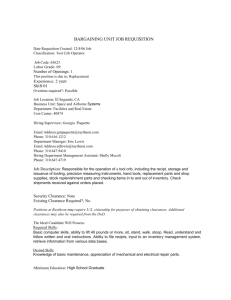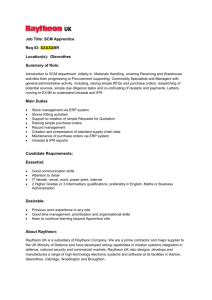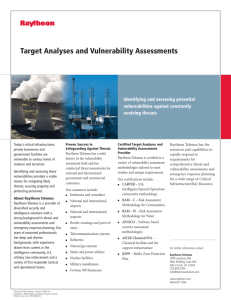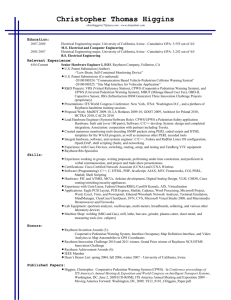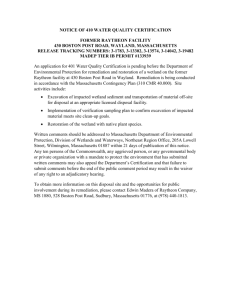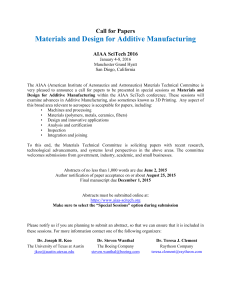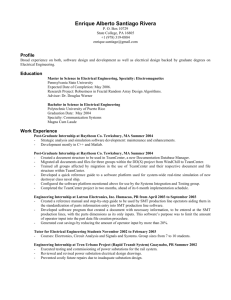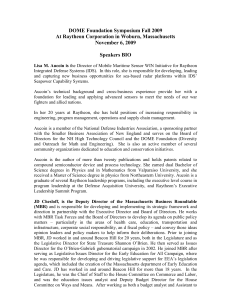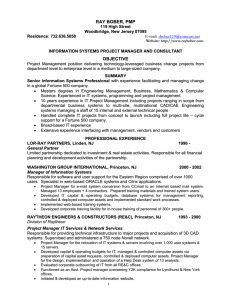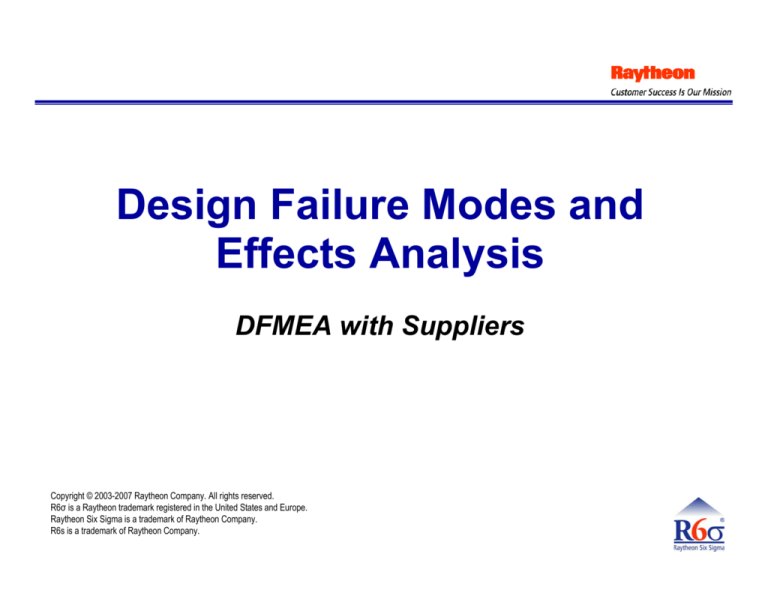
Design Failure Modes and
Effects Analysis
DFMEA with Suppliers
Copyright © 2003-2007 Raytheon Company. All rights reserved.
R6σ is a Raytheon trademark registered in the United States and Europe.
Raytheon Six Sigma is a trademark of Raytheon Company.
R6s is a trademark of Raytheon Company.
Design Failure Modes and Effects Analysis
A structured approach that ensures potential product failure modes
and their associated causes have been considered and
addressed in the product design
– What can go wrong?
– Where will the variation come from?
– How can we prevent or control?
Copyright © 2003–2007 Raytheon Company. All Rights Reserved.
Page 00 - 2
DFMEA Objective
Design and sell products so that in the future the customer returns, NOT
the product
• Performing DFMEAs on existing or new product designs allows:
– Early identification of the ways the product design can fail
– Rational prioritization of potential failures so that corrective/preventive action
and/or redesign can be accomplished before risk and cost can escalate
– Smoother production ramps
– Enhanced system reliability once countermeasures are implemented
– Reduced development, production and warranty cost
– Higher customer and end-user satisfaction
Copyright © 2003–2007 Raytheon Company. All Rights Reserved.
Page 00 - 3
Overview of the DFMEA Process
• People knowledgeable about the product analyze situations where
critical customer requirements might not be met
• A ranking system is used to estimate three factors:
– how Severe the failure would be
– how frequently the failure would Occur,
– how difficult it would be to Detect, and
• These three factors are multiplied and the resulting value is called the
Risk Priority Number (RPN).
• The RPN is used to prioritize the failure modes so that corrective actions
can be taken to reduce the frequency, and severity and/or improve the
detectability of the failure mode.
Copyright © 2003–2007 Raytheon Company. All Rights Reserved.
Page 00 - 4
DFMEA Benefits
• Part of an objective evaluation of design requirements and alternatives
• Helps to identify potential Critical Characteristics and Significant
Characteristics
• Identifies potential failure modes ranked according to their effect on the
customer; establishes a priority system for design improvement and
development testing while still in the design phase
• Provides critical input for the planning of effective design test and
development programs
• Provides an open issue format for recommending and tracking riskreduction actions
• Aids in analyzing field concerns, evaluating design changes and
developing advanced designs
Copyright © 2003–2007 Raytheon Company. All Rights Reserved.
Page 00 - 5
Supplier DFMEA Benefits
• Proactive and collaborative; become more than “just a vendor”
• Identify issues which might drive in-process or post-process failures
• Suggest risk-mitigation alternatives for design incorporation
– Features
– Dimensions
– Materials
– Finishes
– Validation requirements
• Opportunity to influence through added-value during the design phase
• Expected as part of quote package
Copyright © 2003–2007 Raytheon Company. All Rights Reserved.
Page 00 - 6
DFMEA Prerequisites
• Select proper team and organize members
• Select teams for each product or system
• Create/agree on a ranking system
• Agree on format for DFMEA matrix
• Define the customer and customer needs/expectations
• Design requirements
Copyright © 2003–2007 Raytheon Company. All Rights Reserved.
Page 00 - 7
DFMEA Flow
4 Create action plan
to reduce RPN
3 Assign S/O/D ratings
5 Drive actions
Calculate RPN
to resolution
2 Review the
6 Implement
controls
design
1 Assemble
7 Re-baseline
the team
RPNs
FAILURE MODE: How a product can fail to meet design specifications or functional intent
CAUSE: A deficiency that results in a failure mode Î e.g. sources of variation
EFFECT: Impact on customer if the failure mode is not prevented or corrected
Copyright © 2003–2007 Raytheon Company. All Rights Reserved.
Page 00 - 8
Typical DFMEA Team Members
• Design Engineer - Generally the Team Leader
• Project Manager
• Manufacturing/Assembly Engineer
• Process Engineer
• Quality Engineer
• Test Engineer
• Reliability Engineer
• Materials Engineer
• Field Service Engineer
• Component Process Engineer
• Others, as required, including Sales, Marketing, QA/QC, Packaging
Copyright © 2003–2007 Raytheon Company. All Rights Reserved.
Page 00 - 9
Reviewing the Design
• Construct a block diagram that fully describes coupling and interfaces at all
levels; interfaces include controlled inputs (e.g. design parameters) and
uncontrolled inputs (noise factors)
• All design parameter inputs should be associated with a corresponding
component or subsystem providing the input
• Functional requirements (FR’s, or outputs) at each block level are defined
• For each FR, the team brainstorms all potential failure modes that would prevent
the design from failing to satisfy each FR
• For each failure mode, the team brainstorms causes and effects
– Design weakness because of axiom violation (meets specs but fails to perform)
– Manufacturing and/or assembly vulnerability or deficiency
Process variation
Usage
Environmental factors
Mistakes/errors
Deterioration
• Information is used as the input to the DFMEA template
Copyright © 2003–2007 Raytheon Company. All Rights Reserved.
Page 00 - 10
Organizing Information Using the DFMEA
Template
• List each design requirement of concern in each topic area
– Tolerancing/Materials/Finishes/Test specs/Others
• Describe the potential failure modes for each feature/requirement
• Identify the impact of each potential failure mode on downstream processes,
product functionality, system performance or the customer experience
• Identify likely causes in the design or process for these failure modes
• Describe the current design controls—if they exist—that are in place to contain
the failure mode causes
• Assign appropriate values to Severity/Occurrence/Detectability to obtain RPN
(note: scale descriptions are included in DFMEA template)
– Severity: Scale 1-10, 1=no impact, 10=catastrophic impact/hazardous
– Occurrence: Scale 1-10, 1=predicted <3 defects/million, 10=>500K defects/million
– Detectability: Scale 1-10, 1=always detected by current control plan, 10=unable to detect
• Sort design requirements of concern by RPN number high-to-low to prioritize the
action plan for maximum impact
Copyright © 2003–2007 Raytheon Company. All Rights Reserved.
Page 00 - 11
DFMEA Template
DFMEA Template
Copyright © 2003–2007 Raytheon Company. All Rights Reserved.
Page 00 - 12
DFMEA Example
Copyright © 2003–2007 Raytheon Company. All Rights Reserved.
Page 00 - 13
Design Failure Cause Examples
• Improper tolerancing
• Incorrect stress calculations
• Wrong assumptions
• Wrong material callout
• Lower grade component
• Lack of design standards
• Improper heat treatment
• Improper torque callout
Copyright © 2003–2007 Raytheon Company. All Rights Reserved.
Page 00 - 14
DFMEA S/O/D Ratings
Severity
Copyright © 2003–2007 Raytheon Company. All Rights Reserved.
Occurrence
Page 00 - 15
Detectability
Defining the Action Plan
• If the design control in place for the design characteristic are adequate, no further
action is required (typically if RPN value is <20)
• If the design controls for the characteristic are inadequate:
– Identify differences between the current and the desired situation
– Determine how the failure can be better contained and/or eliminated
Consider implementation of new or more effective design controls
Determine if design modification is effective at eliminating or reducing occurrence or
detectability of the failure mode, and if it can be accommodated
• Document plan and reassess S/O/D and RPN values; is it enough?
• Separate between
– Supplier actions
– Raytheon actions
– Joint actions
• Publish result and include in quote/feedback to Raytheon Engineering and
Procurement teams
• Manage to the plan
Copyright © 2003–2007 Raytheon Company. All Rights Reserved.
Page 00 - 16
Typical Design Controls
• Specifying a requirement as a “critical characteristic”
• Reliability tests/design verification tests
• Design reviews
• Worst case stress analysis
• Robust/parameter design
• Environmental stress testing
• Designed experiments
• Finite element analysis
• Variation simulation and statistical tolerance analysis
• Fault Tree Analysis
• Component de-rating
Copyright © 2003–2007 Raytheon Company. All Rights Reserved.
Page 00 - 17
FMEA as Part of ISO9001
Statistical
Process
Control
Failure
Mode and
Effects
Analysis
Measurement
System
Analysis
Quality System
Analysis
ISO-9001
QS-9000
Advanced Product
Quality Planning &
Control Plan
Copyright © 2003–2007 Raytheon Company. All Rights Reserved.
Production Part
Approval Process
Tooling and
Equipment Supplement
Page 00 - 18
Linkage to Raytheon
• DFMEA is a team effort
• DFMEA process promotes actionable input to the design phase
• Enables suppliers to add value and influence designs by highlighting functional
concerns earlier in the design/development process
• The risk of some failure modes will be associated with:
–
–
–
–
–
Supplier process capabilities
Material or finish selection
Design requirements
Design features (or lack of)
Test and/or detection capabilities
• Mitigation action plan includes:
– Supplier actions
– Raytheon actions
– Joint actions
• DFMEA result should be included as part of your quote activity with Raytheon
Copyright © 2003–2007 Raytheon Company. All Rights Reserved.
Page 00 - 19
Resources
Textbooks:
• Failure Mode and Effect Analysis : FMEA from Theory to
Execution; Author : D.H. Stamatis
• The Basics of FMEA; Authors: Robin E. McDermott, Raymond J.
Mikulak, Michael R. Beauregard
On the Web:
• http://www.fmeainfocentre.com/
– http://www.fmeainfocentre.com/examples.htm
• http://www.isixsigma.com/tt/fmea/
• http://www.asq.org/learn-about-quality/process-analysistools/overview/fmea.html
Copyright © 2003–2007 Raytheon Company. All Rights Reserved.
Page 00 - 20
End
Copyright © 2003–2007 Raytheon Company. All Rights Reserved.
Page 00 - 21

